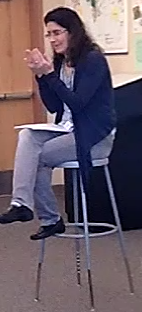The Who, What, Where, and Why of Using Gestures in the AIM Classroom
by Cheryl Roper
So, you work with your Portal at least 15 minutes every night. You’ve memorized the gestures for every word from Section A to Z for your kit. You’ve practiced gesturing whole sentences, partial question, and total questions. You can even gesture the entire play at normal speaking pace and your colleagues say you’re as fluid in motion as a maestro conducting a symphony orchestra. You know that gestures are the key to bringing fluency to your students without using their first language. You know that gestures keep your students engaged physically and mentally in the classroom. You know that, by using gestures, you are giving your students the capacity to story language in two separate parts of their brains. But, are you truly a Gesture Guru? Take this simple quiz and read on to find out.
TRUE or FALSE (answers and explanations found below)
• All students must gesture along with the teacher at all times.
• Students must memorize all gestures and should be tested on them periodically.
• Once students reach critical fluency, the teacher should stop gesturing.
• Teachers should always gesture when they are addressing the class as a whole.
• Gestures are only used during whole group activities.
• Teachers should always gesture, even when speaking to students one-on-one.
#1 – All students must gesture along with the teacher at all times. FALSE! While some students will naturally gesture, others will not; either is acceptable. Students should only be required to gesture when a word is initially introduced or during gesture reviews.
#2 – Students must memorize all gestures and should be tested on them periodically. FALSE! Gestures are a tool used to help build and accelerate fluency. While students do need to recognize gestures so they are able to speak when the teacher gestures, they should NEVER be tested on gestures.
#3 – Once students reach critical fluency, the teacher should stop gesturing. FALSE! The more your students speak, the more fluent they will become, even if they are experienced AIM students. Gesturing, especially when telling personal stories and sharing information, helps students stay engaged with you and in turn, with their learning. Additionally, gesturing allows even your lowest students to understand what is being said.
#4 – Teachers should always gesture when they are addressing the class as a whole. TRUE! Whether it is discussing weekend events, modeling a partner/group activity, or dealing with an ordinary classroom procedure, when you address your class, you should be gesturing for the students to speak with you. In addition to aiding in comprehension, gestures serve as a self-check to teachers. If you don’t know the gesture for a word you want to say, neither do your students. Gesturing keeps you at the same pared-down language level of your students.
#5 – Gestures are only used during whole group activities. FALSE! Gestures are used for so much more. They can be used to assist students in keeping the Target Language Only rule through gestural mirroring. (Example: A student asks for a pencil in the target language and you gesture his sentence so he can ask the question in the target language). They are used to extend student’s language production. (Example: Teachers can change simple statements such as, “I’m looking for my coat.” into “I’m looking for my coat because I can’t find it and I’d like to go outside but it’s very cold today.) They are also used to teach grammar concepts such as gender, verb conjugation, verb tenses, and adjective agreement.
#6 – Teachers should always gesture, even when speaking to students one-on-one. FALSE! When speaking to students individually, in pairs, or in small groups, there is no need to gesture. As long as you stay within the pared-down language and your students understand you, you should NOT be gesturing. The end goal is for students to be able to function outside of the classroom and carry on conversations in the target language without the use of gestures. So, yet, there are times when you do not gesture.
So, did you pass the test? Are you a Gesture Guru? If you’re not quite there yet, that’s okay. We are teachers and we are learners. Continue working towards the goal and have fun conducting your student symphonies, you may get a little bit of a workout in the process!



The post Are you a Gesture Guru? appeared first on AIM Language Learning.






